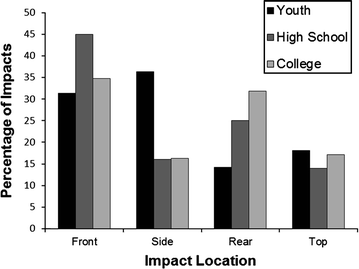Head impact exposure in youth football
- PMID: 22350665
- PMCID: PMC3310979
- DOI: 10.1007/s10439-012-0530-7
Head impact exposure in youth football
Abstract
The head impact exposure for athletes involved in football at the college and high school levels has been well documented; however, the head impact exposure of the youth population involved with football has yet to be investigated, despite its dramatically larger population. The objective of this study was to investigate the head impact exposure in youth football. Impacts were monitored using a custom 12 accelerometer array equipped inside the helmets of seven players aged 7-8 years old during each game and practice for an entire season. A total of 748 impacts were collected from the 7 participating players during the season, with an average of 107 impacts per player. Linear accelerations ranged from 10 to 100 g, and the rotational accelerations ranged from 52 to 7694 rad/s(2). The majority of the high level impacts occurred during practices, with 29 of the 38 impacts above 40 g occurring in practices. Although less frequent, youth football can produce high head accelerations in the range of concussion causing impacts measured in adults. In order to minimize these most severe head impacts, youth football practices should be modified to eliminate high impact drills that do not replicate the game situations.
Figures



References
-
- CDC. Sports related concussions. Agency for Healthcare Research and Quality, HCUIP, 60, 2011.
Publication types
MeSH terms
LinkOut - more resources
Full Text Sources
Other Literature Sources
Medical

